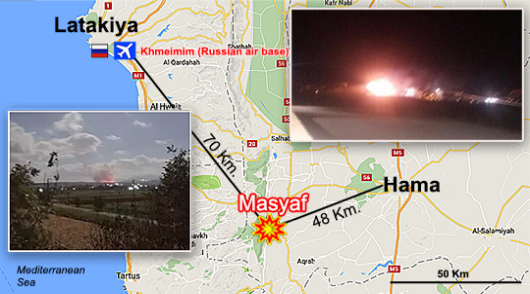Israel Bares NKorean-Syrian WMD Complicity, but Neglects Fresh Iranian Thrust into Syria
Before dawn on Thursday, Sept. 7, Israel carried out an air strike against a facility notoriously blacklisted for producing prohibited chemical weapons and missiles, i.e., the Syrian Scientific Studies and Research Center (CERS) at Masyaf, 38km west of Hama, which the US has accused of producing the sarin which the Assad regime used to bomb its citizens.
Reporting this without official confirmation, Syrian opposition media added photos of high flames.
Damascus later issued a flat statement accusing Israel of killing two Syrian soldiers near Hama with an aerial and missile attack on their post. Israel as usual declined to comment.
On Aug. 24, the German Algemeiner cited a confidential UN report confirming that two North Korean shipments were intercepted in the past six months on their way to a Syrian government agency responsible for the country's chemical weapons program.
The report referred to “two member states which interdicted shipments destined for Syria” and “another member state who informed the panel that the goods were part of a KOMID contract with Syria,"
None of the three nations concerned was identified.
Other sources discovered North Korean engineers or technicians employed at the Syrian CERS plant, which the UN experts had reported as cooperating with KOMID in previous transfers of prohibited items. KOMID was blacklisted by the UN Security Council in 2009, along with its “two representatives” in Syria.
The North Koreans had therefore been caught at their old game of sharing its banned weapons of mass destruction technology and materials with another rogue client.
Thursday’s air strike over Syria occurred ten years to the day since Israeli jets and special ops forces, on Sept. 7, 2007, destroyed a Syrian plutonium reactor under construction by North Korea at Deir ez-Zour. It was destined to serve North Korean and Iranian nuclear programs.
it was revealed at the time, DEBKA Weekly recalls, that the Israeli troops brought home with them components of the wrecked reactor, which were handed over to the United States (George W. Bush was then president) and served US intelligence as vital pointers to North Korean’s nuclear capabilities and aspirations at the time.
Already then, it was possible to discover that Pyongyang and Tehran were in hot pursuit of a hydrogen bomb.
Full details of the latest operation against the Syrian chemical weapons facility are not as yet available – except that the Israeli planes fired their missiles from Lebanese air space.
It is also too soon to determine whether this was a surgical strike or a more comprehensive operation.
However, DEBKA Weekly’s military and intelligence sources can highlight four intriguing questions:
1. Did Israel strike the CERS facility following an understanding reached between Prime Minister Binyamin Netanyahu and President Donald Trump – like his predecessor, Ehud Olmert, who acted on a similar understanding with President George W. Bush for knocking down the reactor at Deir ez-Zour in 2007?
An operation against a joint North Korean-Syrian military facility engaged in developing and making weapons of mass destruction, would suit President Trump down to the ground. It would be the more welcome for being carried out far from the tension-ridden Korean peninsula – and by Israel rather than America.
Not that this will prevent criticism from some US circles, which would not surprise either Jerusalem or Washington.
2. The initial response from Damascus was low key, consisting of an improbable charge that Israel had aimed to “lift morale” in Islamic State’s terrorist ranks, after its painful military setback at Deir ez-Zour (not far from site of the plutonium plant destroyed a decade ago) at the hands of the Syrian army, Hizballah and the Russian air force.
Our sources report that the Assad regime held its fire pending a consultation with President Vladimir Putin and Defense Minister Sergei Shoigu.
Why was that?
3. Because the chemical research facility Israel attacked is located 70km southwest of the Khmemim air base, Russia’s command headquarters in Syria in Latakia province. Housed there, in addition to Russian bombers are the new interconnected Russian and Syrian air defense command centers established there in August.
Russian air defense forces, armed with advanced S-300 and S-400 air defense missiles,, were substantially upgraded in the past month with the arrival of the top-notch Beriev A-50 SRDLO Advanced Early Warning and Command aircraft, as well as K333 Verba Man-Portable Air Defense MANPAD59s.
Some of them were given to Russian units posted in Damascus.
This formidable array of Russian weaponry was sent over to Syria to put an end to the freedom of aerial action enjoyed hitherto by hostile forces, such as the Israeli Air Force and such attacks as the massive US cruise missile bombardment of the Shayrat air base in April.
But, strangely enough, no part of the sophisticated Russian air defense system – just 70km from the target of the Israeli air raid over Masyaf reacted. How is that explained? Moscow might decide instead to “punish” the aggressor with a Syrian air or missile attack.
4. Wednesday night, around eight hours before its air raid over Syria, Israel was confronted with a far more serious and immediate strategic threat, DEBKA Weekly’s military and intelligence sources disclose. Troops of Iran’s Iraqi surrogate, the Popular Mobilization Units (PMU), began surging across the border into Syria.
It was the first time that a pro-Iranian force on the scale of brigades, under the direct command of Al Qods chief Gen. Qassem Soleimani, had crossed into Syria.
But neither Israel nor the US have responded to this peril up until now, any more than the Russians did to the Israeli air strike.
The Israeli air force’s operation had meanwhile exposed, once again, the three-cornered conspiracy by three rogue nations to further their acquisition of weapons of mass destruction.


